It’s time for more bus lanes in Charlotte!
Could more bus lanes be coming to Charlotte soon? We sure hope so! Charlotte City Council’s Transportation, Planning, and Environment Committee heard updates on this and several other topics at their June 22 meeting.
Aligning Corridor Growth & Infrastructure Investment
Assistant City Manager and Director of Planning, Design & Development Taiwo Jaiyeoba explained how the City is working to coordinate their work on many different planning processes.
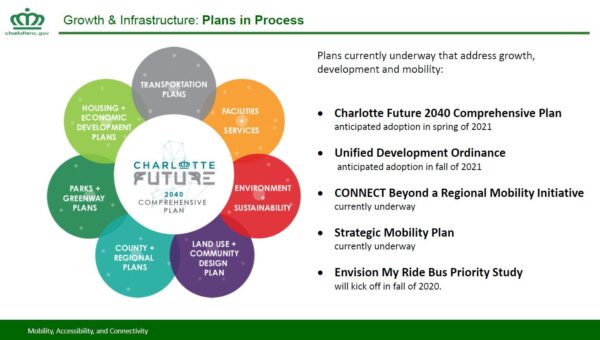
As you can see, the City is creating and supporting multiple land use and transportation plans with overlapping timelines!
Committee member Ed Driggs (District 7, R) asked, “I don’t see how we make a separation between our mobility plan and our comprehensive plan.”
Mr. Jaiyeoba replied, “You are very correct…The success of the comprehensive plan is dependent on how the mobility plan goes.”
]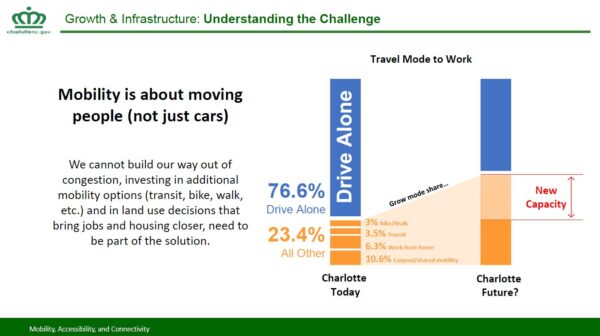
More than 3 out of 4 Charlotteans (76.6%) drive to work alone. If that figure was only 1 in 2 (50%), we’d have new capacity not only to accommodate new growth, but also to use our streets in innovative ways that support transportation equity for all people! But to even get to that point, we need bold leadership that prioritizes street equity now instead of hoping it will come in the future as a byproduct of fewer people driving alone.
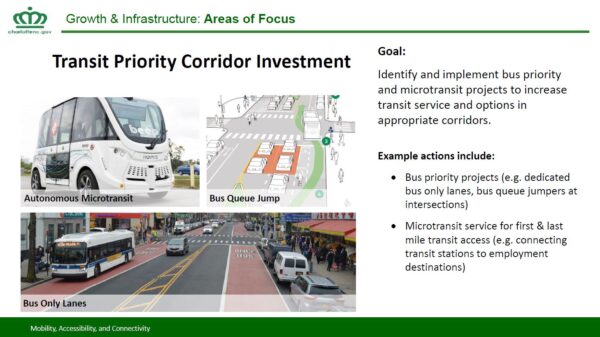
The Charlotte Area Transit System (CATS) and the Charlotte Dept of Transportation (CDOT) worked together at the end of 2019 to launch a highly successful pilot project that converted a lane of 4th St. in Uptown for bus and bike only access.
Committee member Victoria Watlington (District 3, D) highlighted the critical role that public transit plays in connecting people to opportunity when it’s properly aligned with land use planning: “I would love to see data layered on existing public transit routes.”
The interest in transit was emphasized by committee member Braxton Winston (At Large, D): “There’s been a big disruption in travel patterns due to Covid. How has travel amongst the corridors and adjacent neighborhoods changed? Are people staying closer to home?” Mr. Jaiyeoba said that CATS is being responsive to changing transit use patterns and rider needs by modifying service on the 10 highest ridership bus routes. Instead of operating on a fixed schedule, those routes will now have buses come every 15 minutes throughout the day. This will give riders a more “light rail-like” level of service predictability. When a bus route is frequent and comes regularly, riders are freed from having to consult a schedule. They can just head to the bus stop and know that a vehicle will come soon to take them to their destination. We applaud CATS’ shift to service that’s meeting the needs of riders in this uncertain age of social distancing and changing travel patterns!
Committee Chair Julie Eiselt (At Large & Mayor Pro Tem; D) said, “We’ve been talking about Central Ave [piloting a bus lane] for awhile. Now is the time to try these things.” She was referring to the reduced traffic volumes due to the Covid health situation. In our blog post last month, we highlighted all of the reasons that Charlotte will need to prioritize buses if we want to get serious, as a city, about ensuring that people of all ability levels and income levels have access to jobs, daily needs, and community.
All too often, political decisions about addressing congestion get pushed down the road (pun intended) by elected officials since their terms are only 2 years and congestion is a problem that gradually worsens over time. It’s easy to ignore and hope the next person in office will fix it. And let’s face it: There’s political risk in asking a city that’s been almost entirely auto-dominated for the last 70+ years to re-allocate even a small amount of street space away from cars and towards people walking, biking, and riding transit. We’re grateful for Mayor Pro Tem Eiselt’s leadership in asking the City to make brave decisions about prioritizing the need to equitably move people rather than just cars with 1 person driving!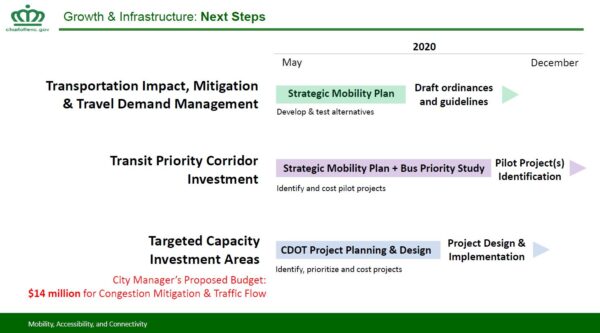
Tree Canopy Action Plan
Deputy Planning Director Alyson Craig and Tim Porter presented on the City’s planning process to ensure a healthy tree canopy now and into the future. This is an ACTION plan, with emphasis on the word “action”. It’s intended to act on, not to replace, the Urban Forestry Master Plan.
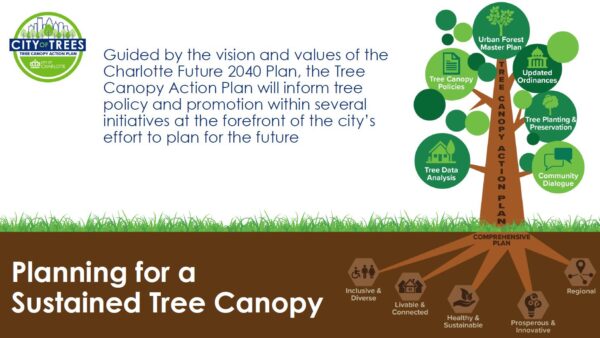
The Tree Canopy Action Plan is closely tied to the guiding principles of the Charlotte Future 2040 Comprehensive Plan, as you can see in the “tree roots” in the image above. Mr. Porter confirmed that analysis shows Charlotte’s tree canopy experienced a noticeable decline in recent years. We’ve lost 4% of our tree canopy between 2012 and 2018. Yikes!
Committee member Ed Driggs questioned whether the current goal of achieving a 50% tree canopy by the year 2050 is realistic. He said, “50% [projected] population growth will lead to some tough choices.” While we agree with Mr. Driggs that it will be a huge challenge to protect Charlotte’s beloved tree canopy in light of not only major population growth but also aging of the existing trees, we believe that smart growth that concentrates new growth near existing development and reduces sprawl will help to achieve Charlotte’s goals of both economic growth and protection of the natural environment.
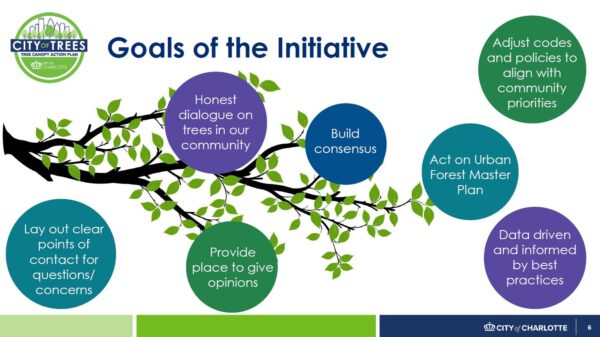
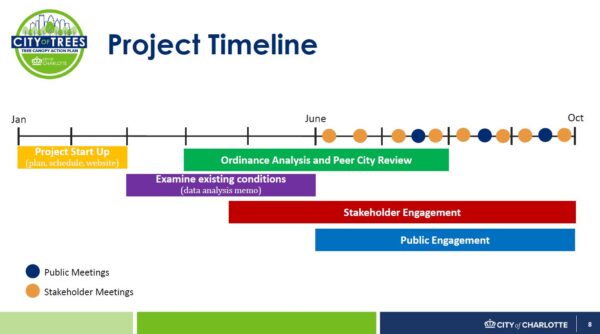
Our Bike + Walk Program Coordinator, Eric Zaverl, attends meetings of the Tree Canopy Action Plan Stakeholder Group and gives input to support a healthy tree canopy.
Your Turn: Learn more about the Tree Canopy Action Plan and sign up to receive updates from the City.
All In 2040: Center City Vision Plan
Charlotte Center City Partners CEO Michael Smith gave an update on this 20-year plan that will be adopted by Charlotte City Council and then implemented by both the City and the private sector.
The purpose of the plan is to be:
- A fresh start for a different city
- Deep authentic reflection of community priorities
- Extension of previous planning efforts
- Once in a generation opportunity for coordination and alignment with other plans
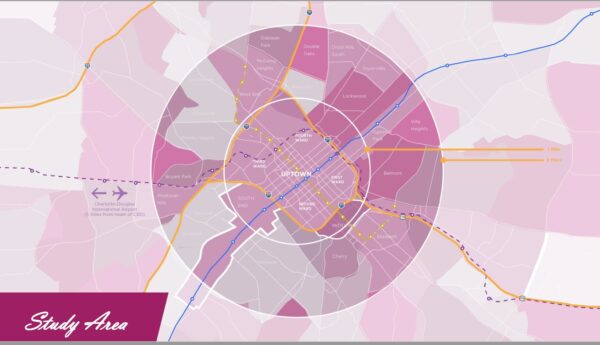
The plan will focus on Center City Charlotte, which includes Uptown and an approximately 2-mile radius from Trade & Tryon.
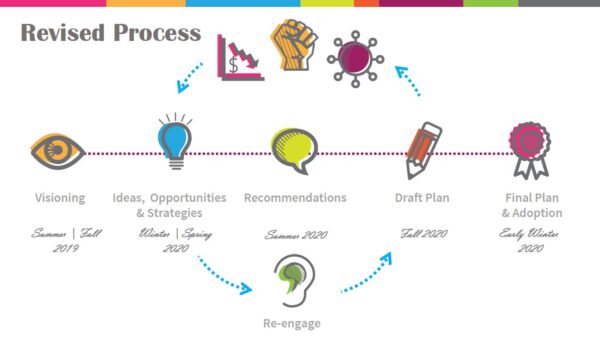
Why has the process been revised? Mr. Smith explained that much has changed across the nation and in Charlotte since the plan’s engagement process began: “We will seek to heal old wounds and to remedy past actions that divided our people and our neighborhoods.” In Charlotte, one such past action was the construction of interstates and major highways that cut through communities of color. The scars of separation exist today as people living in these communities continue to suffer from lack of physical connection to their former neighbors and to opportunity.”
Committee Chair Eiselt said, “Uptown isn’t an easy place for everyone to get to. We hear from lower income residents that they can’t afford to drive to Uptown and park…they don’t have access to light rail, there’s a lack of safe bike and pedestrian and scooter infrastructure,” and added that Charlotte needs to “make Uptown an inclusive place where everyone really does have access.” We couldn’t agree more!
“The days of designing cities for cars only are behind us.” said Mr. Smith. We’re excited to see some real options presented for re-envisioning I-277 and the Uptown portion of Tryon!
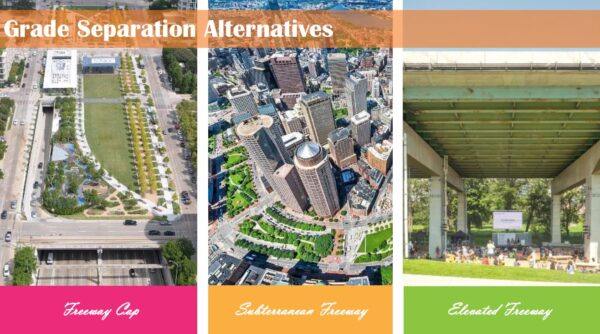
A variety of alternatives were shared for replacing I-277. Yes, that’s right. I-277 could disappear at some point in the future and we’d be happy to see it go.
Committee member Larken Egleston (District 1, D) said, “277 doesn’t work effectively.” and explained how this roadway doesn’t meet the transportation nor the land use needs of the community. Many people using it are just cutting across Charlotte on their way to somewhere else, and it’s redundant with the existing street network. It also physically cuts off adjacent neighborhoods from accessing Uptown without a car.
Mr. Smith shared examples of how other cities across the U.S. have transformed their urban beltways through freeway caps, making the freeway subterranean, or elevating the freeways.
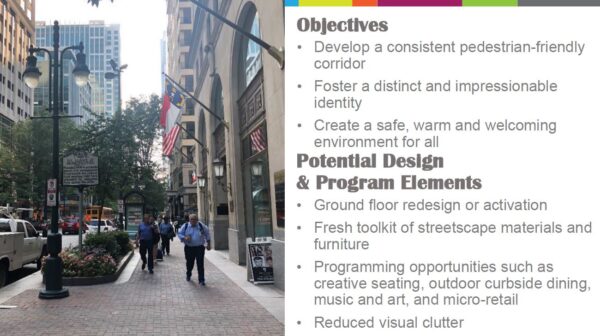
The plan will also re-examine how the Uptown portion of Tryon Street could better serve as the heart of Uptown for all people. With the recent installation of the beautiful Black Lives Matter street mural, here at Sustain Charlotte we can’t think of a better time to transition this portion of Tryon to a permanent pedestrian plaza!
One more issue that needs to be dealt with is parking. Committee Chair Eiselt asked about zoning and parking: “Most buildings in Uptown are zoned UMUD [Uptown Mixed Use Development], with no parking restriction. What is going to be the growth of parking garages in Uptown? We have a ton of [surface] parking — What’s the plan for when that goes away? How does that balance with multimodal transportation, which we want to continue to invest in?” She requested that these parking considerations be included in the community conversation and outreach, and Mr. Smith replied that they would be.
There’s a lot more we’d like to share about the Center City Vision Plan, so we’ll continue to update you as the plan develops and share ways to get involved.
Your Turn: Learn more about the Center City Vision Plan.
Thanks for reading!
As a nonprofit, community support is essential for us to keep doing what we do — including providing free articles like this. If you found this article helpful, please consider supporting Sustain Charlotte.
Want to stay in the loop? Subscribe to our weekly newsletter and follow us on Instagram, Facebook, and Twitter.
